My husband and I started our “fertility journey”—as infertility nightmares are euphemistically called—just before the iPhone era began. Every morning, I took my temperature with a special pink thermometer, careful not to get out of bed or move enough to alter the reading. We noted that number on a pad of paper and later transferred it to a rumpled chart. Books full of fertility advice crowded the bedside table. None of us knew then how much the iPhone would simplify even these most intimate parts of our lives.
Today all iPhones ship with a built-in app, Health, that acts as a collection point for health data. And there’s a lot of that data—the use of health and fitness apps grew more than 330% between 2015 and 2017 according to Flurry Analytics. With the release of iOS 13 (due out in a few months, but available now in public beta), Health has grown beyond being just a weak database of health-related metrics. It’s now a tool that not only tracks more types of data—including the fertility indicators I once logged by hand—but also actively helps users manage and understand that information by offering insights into their health trends.
Your Health, at a Glance
The Health app serves as a dashboard for data you enter directly or—more likely—collect using compatible apps and health devices such as smart scales, smart insulin pens, and fitness trackers (including the Apple Watch). The first thing you see when you open iOS 13’s Health app is the new, information-packed Summary view. The Favorites section shows recent entries in categories you check often, like your exercise minute count. The Highlights section offers dynamic charts, with the app analyzing current and past data to provide a historical perspective on what’s going on. This is a quick way to get feedback, for instance, if you’ve been exercising less than usual or your blood sugar levels are trending upwards.
Tap any category in the Summary view to see highlights specific to it. The more data you have, the more insight this will give you. You can filter many charts interactively by hour, day, week, month, or year. In most cases, you’ll also find basic educational material, drawn from sources like the Mayo Clinic and the National Institutes of Health, to explain the category’s significance to your health.
If you’re looking for something in particular, tap Browse at the bottom of the window. Enter a term in the search field or explore the list of categories shown here.
If exercise is your main concern, you’ll find additional tools in iOS 13’s updated Activity app. It will chart your progress with key activity metrics, such as your walk and run pace, comparing the previous 90 days with the last 365 days and offering personalized challenges and coaching if you start to trend down.
Tools for Tracking Menstruation and Fertility
When Apple’s Craig Federighi first introduced the Health app back in 2014, he billed it as a dashboard where you could “monitor all of your metrics you’re most interested in” no matter what app or health device they might come from. But the Health app lacked any way to track or record data about menstrual cycles, leaving out a sizeable portion of Apple’s customer base. (You know, women.) A year later, iOS 9’s Health app added basic reproductive health tools, but iOS 13 takes things to the next level, offering more visual charting and cycle statistics, as well as prediction and notification, which makes it much more useful on a daily basis.
Using past data as its guide—whether you’ve entered it into the Health app itself or into a third-party reproductive health app like Glow or Clue—Health now predicts the likely start of your next three cycles, making it easy to get an idea what the situation will be for upcoming pool parties and romantic vacations. By default, Health also warns you at 8 PM on the day before your period is predicted so you don’t walk out the door without supplies. Likewise, if you’re trying to conceive, Health can predict when you’re nearing your “fertile window”—in other words, the time when ovulation is expected—and notify you the night before.
To make it easier to log menstruation as well as pre- and post-menstrual symptoms like sleep and appetite changes, Apple announced that watchOS 6 (likely to ship alongside iOS 13) would include a companion app, Cycle Tracking. It will let you see predictions and notifications on your wrist, too.
Is Apple in the fitness tracker vanguard with this? Not quite. Fitbit added menstrual cycle tracking in 2018 as did Garmin, earlier this year. (Of the three, only Garmin offers specific features for menopause symptom tracking—something many women deal with for years—though you can log hot flashes with Health.)
Tools to Protect Your Ears
The number of Americans with hearing loss doubled between 2000 and 2015, according to the Hearing Health Foundation, bringing the total affected to nearly 50 million. In most cases, noise-induced hearing loss caused by continuous exposure to loud sounds (rather than a sudden explosion) is preventable. That’s where the Health app’s new hearing tools come in.
Health now tracks headphone audio levels, noting if your exposure reaches dangerous levels. That means if you regularly crank up your tunes, you can check the app to see whether you’re putting your ears at risk. (To reduce an iPhone’s maximum volume, go to Settings > Music > Volume Limit and move the slider to the left.) Likewise, if you see your headphone volume level trending up in Health’s Highlights, it might be time to see your doctor about declining hearing. Proactive notifications that nudge you to make changes would make these tools even more useful.
If you have an Apple Watch running watchOS 6, it will work with the Health app to warn you about the sounds around you, too, whether they come from a concert or a construction site. If the decibels get dangerous, your watch taps you on the wrist and displays a warning; a notification also appears at the top of Health’s Summary view.
You can adjust the sensitivity in the Watch app on your iPhone depending on how careful you want to be with your ears. Reaching the preset maximum, 90 dB, wasn’t difficult with Ozzy Osbourne playing full blast on a HomePod. That was also about the level that Josh Centers found lawnmowing to be (see “3M WorkTunes Headphones Make Yardwork More Tolerable,” 12 April 2019).
From Health Hub to Health Helper
When it comes to your health, knowledge is power. Making it easy to gather data, track symptoms, and draw basic conclusions about the state of your health makes it more likely you’ll arrive at the doctor’s office with the information you need to get good care. Or, even better, perhaps this data can help you change your habits and behavior so you don’t have to schedule that doctor’s appointment in the first place.
Whether it’s protecting your ears or alerting you that the time is ripe for baby-making, iOS 13’s Health app not only gathers more of our scattered health information but also helps us use it in practical and potentially profound ways. My daughter, now 11, will likely never be able to imagine otherwise.
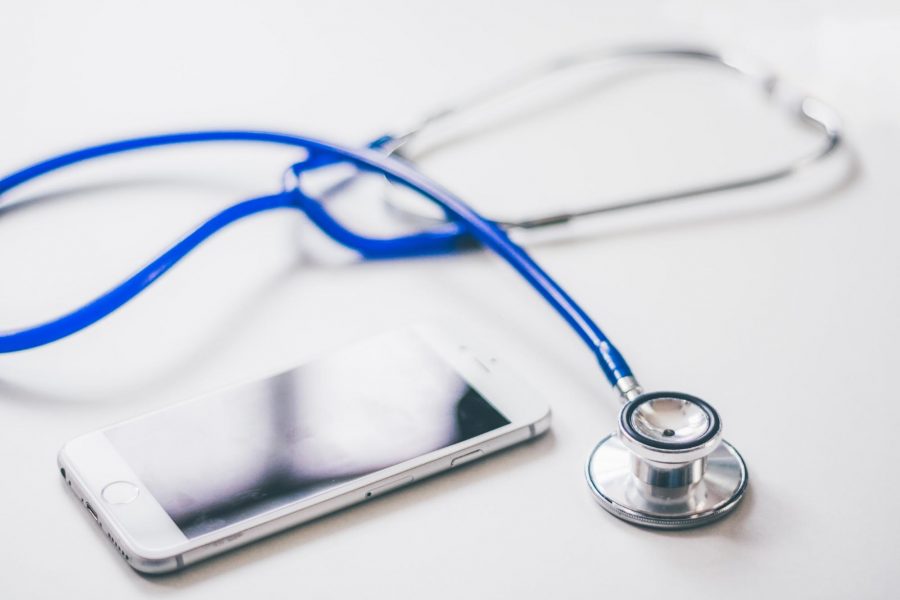
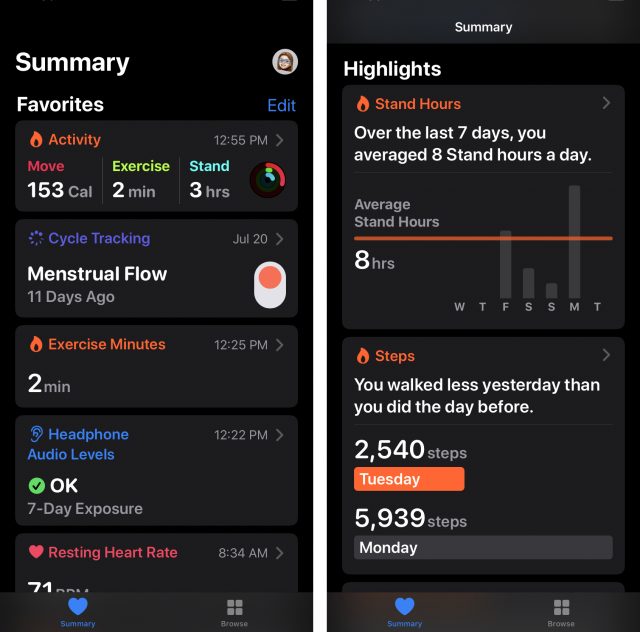
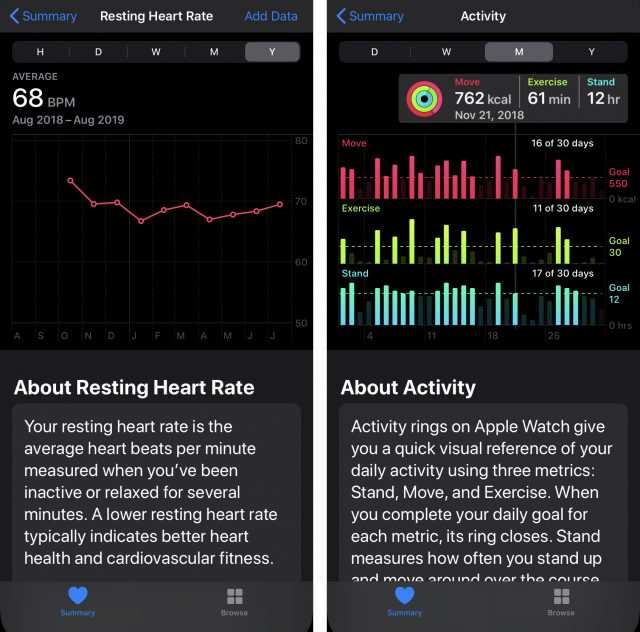
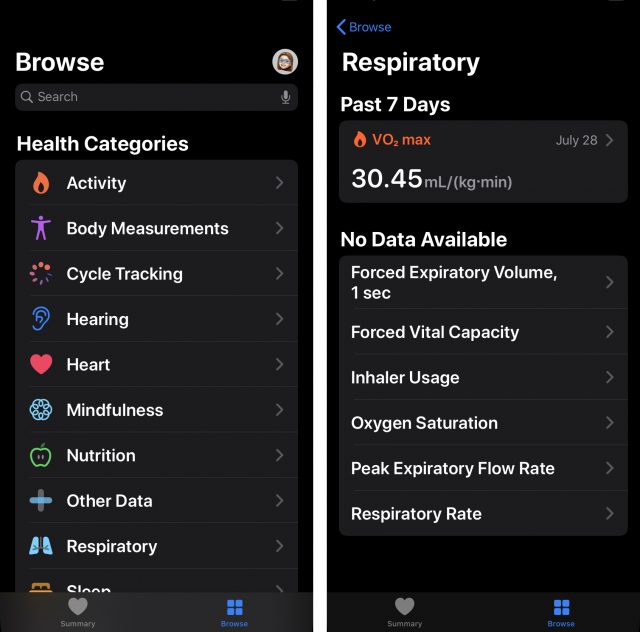
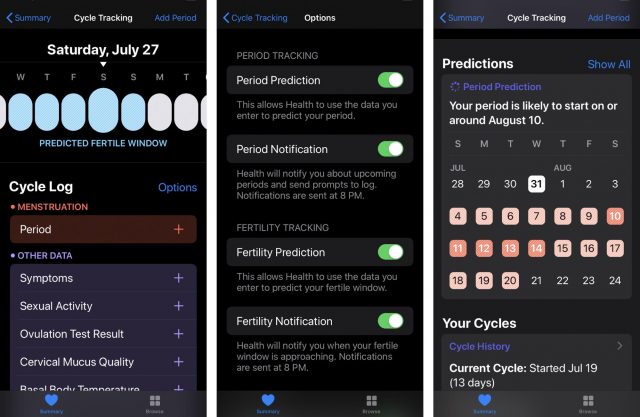
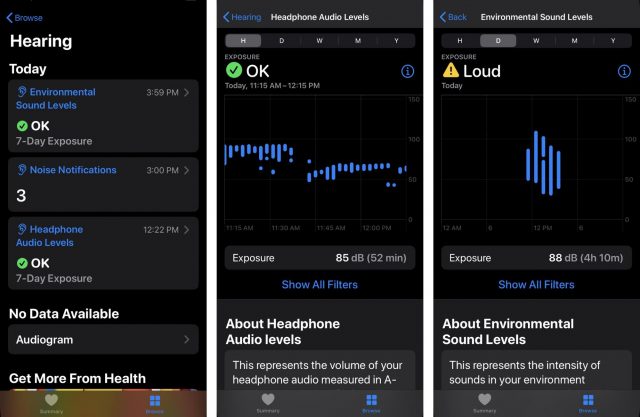
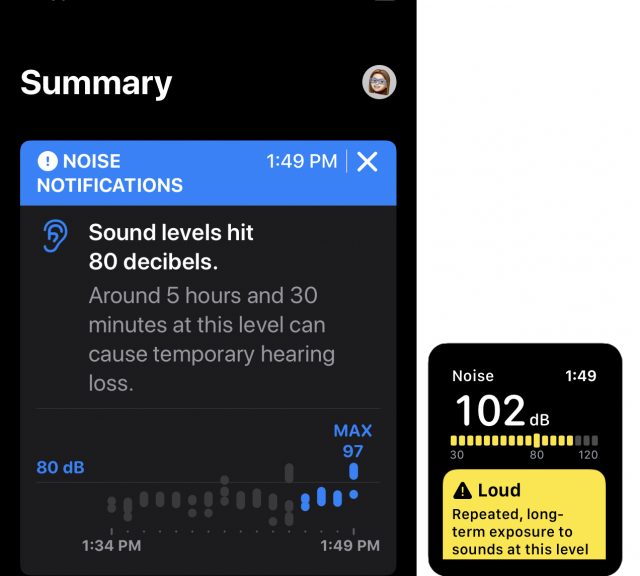
What I don’t get about the Health app on the iPhone is why it won’t sync active energy properly to MyFitnessPal (where I do calorie logging) even though it syncs the steps correctly. So I have to use MapMyRun to sync workouts. If the Health app synced calories correctly it would be better because it’s monitoring all the time.
I also don’t get what the Health app on my Apple Watch (series 1) adds that the Health app on my iPhone is already doing, since I carry my iPhone in my shirt pocket wherever I go.
Why an article on the health app in IOS 13 when IOS 13 isn’t yet available. Are we really doing articles based on betas that aren’t generally available.
I think Tidbits is jumping the gun here doing articles on apps in versions that aren’t yet completed or generally available to most readers.
There is nothing wrong it’s an article about future Apple OS features, as long as it’s based on information that has been publicly released, usually at WWDC.
But you are correct that this article goes beyond that in that it appears to be mostly based on public beta experiences, including screen shots that are specifically prohibited by the Apple NDA associated with said beta.
Further more, it is common to see features included in beta releases disappear from the release version when they prove not ready for prime time.
It’s not up to me or any other reader to do more than point this out. It’s up to Apple to enforce it’s own rules, should they choose to.
I am also interested in the current version of the app and it’s ongoing issues. In my case it seems to read some data points from my preferred cycling app, iCardio, twice, so recorded distances are far too large, whereas other data like steps seem right. I think there may be issues here that affect developers of other fitness apps. I would like to see an informed review of the app’s data collection methods before learning about semi-publised new features.
Two thoughts. First is that iOS 13 absolutely is available as a public beta to anyone who wants to try it. Second, is that if we fail to cover things that are in wide circulation and coming very soon (could be 30-45 days), then we just suffer in comparison to every other site that’s doing such coverage. No one will say “Wow, I’ll read TidBITS because they’re not covering iOS 13 yet.”
We’ve given up on following the Apple NDA. If Apple isn’t going to enforce it, it’s worthless. (Failure to enforce is a problem in certain areas of the law. If you don’t protect a trademark, for instance, you lose it.) As I mentioned above, all that following the NDA does is ensure that our coverage is far, far later than articles from any other publication. And that hurts us forever, since search engines will see those other articles as more relevant because they’ll have gotten a lot more attention and links early on. Heck, there are plenty of YouTube videos showing off the developer betas—here’s 9to5Mac showing the changes in Beta 5.
All that said, we’re not writing about things that don’t work, things that are likely to change, or anything that we don’t think will be useful once the final release comes out.
A fine topic for discussion in TidBITS Talk, but definitely not something we’d write about in TidBITS because the article would be obsolete within weeks.
I tend to agree that articles on using future features aren’t as helpful in advance of release. Most people don’t have the new software, and the main value then is raising interest in future features. The primary time I need info is when the software is actually out here, and I have to figure out how to use it myself. And I have to think “Where did I see those instructions?” And then search around my sources for the last few months.
I’d rather have complete articles on the full released software coming out at release time. Same thing happened with Mojave - all the new features were months old in publications, and often easier to work out myself. And then I’d always miss something important. IMHO.
Fair enough. Clearly, we’re not publishing a great deal about iOS 13 or macOS 10.15 Catalina right now. But do keep in mind that if everything has to wait until it’s live, some things will never get covered because it’s WAY too much to fit in even over months.
Count me as one person who is interested in these articles, and thank you for providing them. There are topics that Tidbits publishes that do not interest me, but I just don’t read those articles.
For those of us who are waiting for the official release of new system software, it would be nice if TIdbits does two things upon the official release:
Publish a list of links to the relevant articles that discussed the items while they were in beta.
Update those articles to correspond to any updates that occurred prior to the production release.
About the health app - one protects one’s ears by not exposing your ears to loud sounds for a long period of time when you are young (under 65:-). If you are older, and have age and genetic hearing loss and use hearing aids, does it further damage your ears now that you must use a higher settings on your phone than is “safe” for a younger person?
I agree that these extra steps that Alan suggests would be a good resource after the release. It would in MHO answer many of the objections expressed above. I would also count myself as one who appreciates the concept of writing this type of article during the Public Beta. There is so much to cover that it makes sense to start as early as possible to avoid overload (for both writers and readers) on official release day.
New Zealander’s are notorious early adopters and I’m using the public beta on my phone and Mac, like many others. Therefore for me and others these type of subjects are very current.
We link heavily to past articles, so any time there’s an appropriate context within a new article, there will be a link back. And we have an “iOS 13” tag appearing at the bottom of every appropriate article that, when clicked, brings together all those articles.
That we won’t do—we have a strict policy against historical revisionism. The only changes that are ever made to an article after an issue goes out are fixes for typos or very explicitly marked updates in a case where future readers would be seriously misled by the old information.
The comment stream for an article is where such updates can be made, either by us or by readers. Or, if the changes are sufficiently major, we could write a new article. But if we’re doing our job right, there won’t be enough changes for that to happen.
The simple fact of the matter is that we have way too large of an archive—many thousands of articles over 29 years—to be going back and adjusting content after the fact.
That’s a fabulous question, and we really need someone with medical experience to answer it. @ron, would you know anything about this? Or any other doctors in the audience?
I’m a simple family doctor and headshrinker, not an otolaryngologist or audiologist. I would suggest, however, that the answer is “probably not.” The more common affliction in old age is hyperacusis, where the mechanism that damps loud sounds don’t work as well. That combines with selective hearing loss at specific frequencies from prolonged exposure to too much sound pressure damaging cochlear nerve fibers. The result is that folks will have trouble understanding spoken words, so they turn up the volume, but the loud volume becomes unpleasant, so they turn it down and then up again when they start losing audibility. The result is a very different type of exposure than, say, listening to very loud music at a concert venue (which a hyperacusis sufferer would be likely to avoid, consciously or otherwise) or industrial exposure.
In the end, it’s probably quite individual. Certainly the stereotype oldster is more likely to be listening to spoken word or to music that doesn’t endorse the “if it’s too loud, you’re too old” volume guidelines, but I have older friends who are still playing rock and roll, the volume on my car sound system actually goes up to 11, and I’ll be at a flat track motorcycle race this weekend. But those exposures are more a continuation of exposures begun in my misspent youth than a result of any age-related hearing loss. No doubt somebody out there has damaged their hearing further by cranking up the volume due to hearing loss, but I’m guessing that is only a very small contribution to further hearing loss in the aged.
–Ron
Here’s an article about how menstruation-tracking apps regularly share data with Facebook and advertisers, including when you last had sex. If you’re using an app to get such data into Health, you might want to choose the one (Period Tracker by GP International) that doesn’t do this. Otherwise, it’s a cautionary tale that gives Apple’s strong stance on privacy a boost.